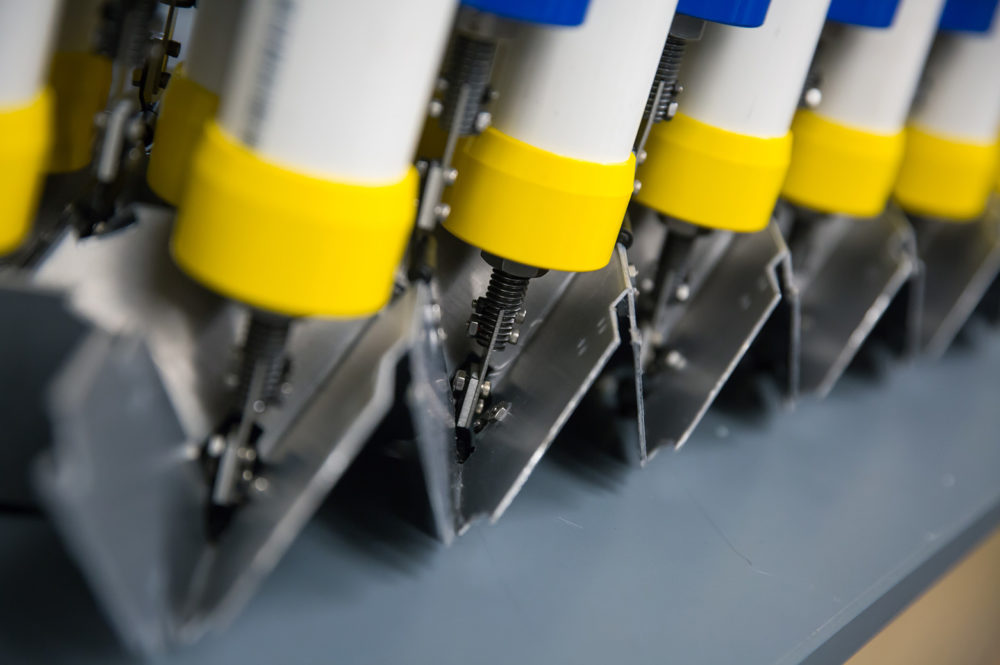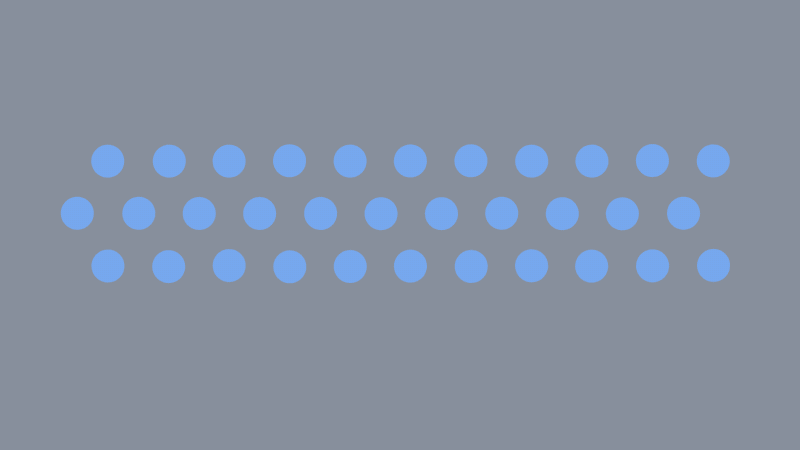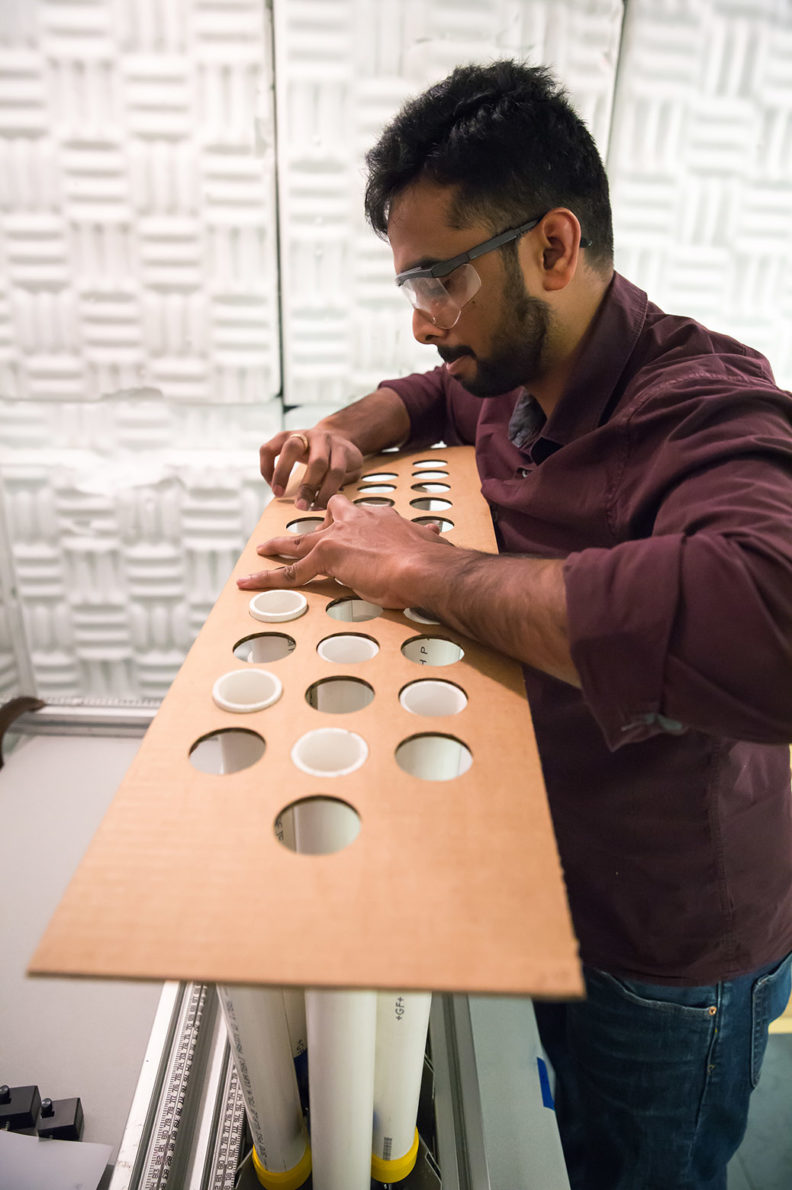
Managing traffic noise pollution has vexed researchers because of the broad range of audio frequencies that emanate from roads. Currently, only heavy, inflexible, wall-like barriers can reduce all of these sounds.
Researchers at Michigan Engineering have brought a new method into the fold, developing an adaptive origami lattice structure that could quiet acoustic noise in roadways. There has been growing concern about the impact noise pollution has on blood pressure, hearing loss and attentiveness at work and school.
The work has been published in the Journal of Applied Physics. The authors are Manoj Thota, a doctoral student in mechanical engineering, and Kon-Well Wang, the Tim Manganello/BorgWarner Chair and the Stephen P. Timoshenko Collegiate Professor of Mechanical Engineering at the University of Michigan.
How it works
The new architecture consists of a base that’s creased into a sort of cross-hatched accordion pattern known as a Miura fold. Cylindrical rods jut up from the cross points of the creases in the base. This structure allows researchers to tune the structure to selectively reduce noise at different frequencies.
“It is known that if you reconfigure the lattice structure in such a manner, you will change the sound wave propagation characteristics significantly,” said Wang. “Our main contribution is we’re developing an adaptive structure that can change its periodicity between different Bravais lattices with distinct symmetry properties.” Bravais lattices represent a class of crystal structures.

“The resulting lattice contains only one degree of freedom, making it particularly easy to collapse and expand,” said Thota. “As the lattice collapses or expands, the cylinders are drawn closer together or further apart, diffusing noise in different frequency ranges.”
The basic theory and concept of utilizing origami lattice reconfiguration for phononic bandgap adaptation was published earlier this year by the authors in their paper in Physical Review B.
The researchers tested their design on a tabletop model and demonstrated that it that can disperse noise across the traffic spectrum of 500 to 1,200 Hertz. Heavier vehicles produce noise at lower frequencies than lighter vehicles. And cars traveling quickly during off-peak times skew toward higher frequencies than those stuck in traffic jams.
In a prototype, Thota and Wang found their barrier reduced acoustic pressure by 10 decibels, or 90 percent.
“The traffic noise that could otherwise be heard as far as a mile away would now only be perceived from a distance of 0.3 miles with these barriers,” Thota said. “That is comparable to the insertion loss in barriers used today, except this can be adapted for certain frequencies. Further, this kind of structure has corrugated façade and top edge, which will have better sound diffusion properties than traditional barriers.”
Addressing a health concern
Traffic is considered one of the major sources of noise pollution in an urban environment, the researchers say.
“With the increase in urban population, the number of vehicles on the road has increased exponentially, and the associated traffic noise pollution is also peaking,” the researchers wrote. “Noise pollution is defined as harmful level of sound that disturbs the natural rhythm of the human body.”
Ongoing loud noise has been blamed for health issues such as sleep apnea, stress, fatigue and high blood pressure, the researchers say. And traffic noise can interfere with cognitive functions including attention, concentration, memory, reading ability and sound discrimination—leading to a less productive work environment.
When sound waves are impinged on traditional concrete walls, they reflect back into the roadside, said Thota. Further, with a straight top edge, the incidence of oblique waves onto these traditional barriers leads to higher diffraction and increases the sound propagation across the barrier.
Improving a tested technique

The researchers’ work draws on periodic sounds barriers, in which a series of vertical structures reduce sound at certain frequencies while allowing wind to pass through, as installed in Eindhoven in the Netherlands. The drawback, Thota said, is that these systems are fixed designs. If a system is designed to alleviate noise from traffic jams, it’s not as useful when cars are moving fast.
Benefits of origami structures might extend out of traffic noise reduction, Wang said, citing its potential in achieving other adaptive functions in wave guiding and acoustic diodes.
“Overall, origami structure gives us an effective platform to adapt to environmental change,” Wang said.
The research was supported by the National Science Foundation and Wang’s U-M collegiate professorship.
